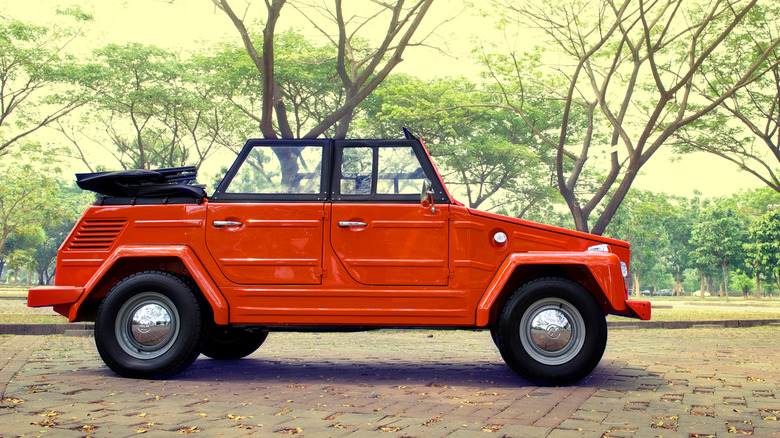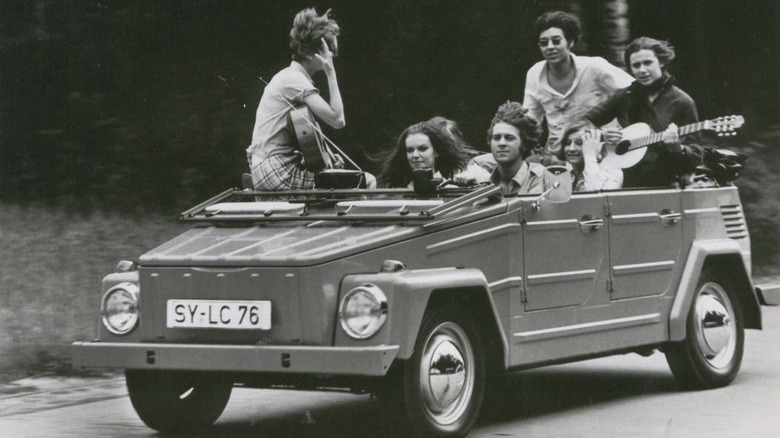Why The VW Thing Was Much Cooler Than People Realize
Volkswagen rolled out "The Thing" in 1973 to the United States, hoping to appeal to surfers, hippies, and counterculture-types who had adventure coursing through their veins. It was boxy, stubby, and devoid of any bells or whistles. Aside from being able to stop it and steer it, it lacked even the most basic safety features. Only available in Blizzard White, Sunshine Yellow, or Pumpkin Orange ... a thing of beauty, it was not.
Customers could take off all four doors in minutes, throw back the PVC convertible top, fold down the front windshield, and have an instant Dune Buggy on their hands. Upon returning from their grand escapades, they could turn on a hose and wash down the entire car, because there was nothing but bare corrugated metal and non-mildewing seats inside this rough, versatile, go-anywhere (albeit slowly) utility machine.
The aptly named "Thing" actually began life as a military Jeep knockoff during the height of the Cold War in the late 1960s. Axis powers France, Italy, and West Germany got together to develop an all-wheel-drive, amphibious vehicle called the Europa Jeep (via Motor Trend). Still, it didn't come together fast enough, so Volkswagen entered the fray and brought forth this vehicle based on its VW Type 182 Kübelwagen used during World War II with a Beetle chassis, driveline, and the suspension from a Transporter Type 2.
The Thing was basically Frankenstein's monster car
While "The Thing" was only available in the United States for two years, from 1973 to 1974, it was first released in the fall of 1969 to the European market as the "Type 181" (via Hot Cars).
VW moved production of the 181 from Germany to Mexico in 1973, where it was subsequently called the Safari. It was referred to as "Camat" in Indonesia and the "Trekker" in England. It probably would have been the "Safari" in the U.S. if not for a Pontiac station wagon already on the road by that name. Considering "The Thing" looked like Frankenstein's monster made up of a little bit of the Beetle, a splash of the Type 2 bus, and a dash of Karmann Ghia (via Motor Trend) ... the name was a perfect fit.
According to a 2020 Environmental Protection Agency (EPA) report, the average vehicle weight was 4,156 pounds. "The Thing" had a shipping weight of only 1,984 pounds and a gross weight of 2,954. According to Motor Trend, it took 23.2 seconds to reach 60 miles per hour, with a top speed of only eight more miles per hour. It wasn't getting you anywhere fast. But it promised endless top-down fun in the sun.
The Thing that never dies
Production of "The Thing" came to a grinding halt in 1975 when the U.S. — led by Ralph Nader — introduced tougher vehicle safety measures. Remember, this buggy was essentially bereft of any safety features, so it makes complete sense that such a ridiculous bare-bones car could be considered a death trap. However, production of the vehicle continued in Mexico until 1980.
Even at an initial cost of roughly $3,000, only 25,000 people (via Motor Trend) ever purchased the ugly car that tried to be everything to everyone. But according to Hagerty, "The Thing" has seen a resurgence in popularity over the last decade or so. Between 2010 and 2018, sales data shows the Type 181 was growing 10 percent annually, with auction sales of the vehicle averaging around $22,900 and even going as high as $42,900.
It certainly wasn't a beauty queen when it first hit the road, but nostalgia always makes us look at things again through rose-colored glasses.

